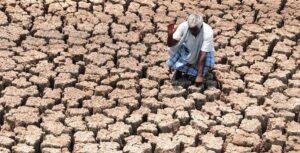Southern Australia is currently enduring a crippling drought, with swathes of South Australia, Victoria, Tasmania, and Western Australia experiencing some of the lowest rainfall totals on record. This prolonged dry spell is putting immense pressure on communities, ecosystems, and economies serving as a stark warning of what may become more frequent as climate change intensifies.

𝗙𝗮𝗿𝗺𝗲𝗿𝘀 𝗨𝗻𝗱𝗲𝗿 𝗦𝗶𝗲𝗴𝗲: 𝗙𝗲𝗲𝗱 𝗖𝗼𝘀𝘁𝘀 𝗦𝗼𝗮𝗿, 𝗟𝗶𝘃𝗲𝘀𝘁𝗼𝗰𝗸 𝗦𝗮𝗰𝗿𝗶𝗳𝗶𝗰𝗲𝗱
With pastures failing, many farmers are being forced to purchase feed at sky-high prices just to keep their animals alive. Others are selling off livestock in distress sales, trying to cut losses. These decisions often heartbreaking are being made daily across vast tracts of agricultural land.
Financial stress is mounting. For many, the economic cost is snowballing, and the emotional toll is no less severe. Years of droughts, floods, and now prolonged dry conditions are stretching resilience to its limits.
𝗧𝗼𝘄𝗻𝘀 𝗢𝗻 𝗘𝗱𝗴𝗲: 𝗪𝗮𝘁𝗲𝗿 𝗥𝗲𝘀𝘁𝗿𝗶𝗰𝘁𝗶𝗼𝗻𝘀 𝗮𝗻𝗱 𝗧𝗿𝘂𝗰𝗸𝗲𝗱-𝗜𝗻 𝗦𝘂𝗽𝗽𝗹𝗶𝗲𝘀
Some rural towns are already under water restrictions. In regions not connected to the main water supply, such as parts of the Adelaide Hills, the situation is even more dire. Here, water is being trucked in to fill dry rainwater tanks and empty dams.
Adelaide has activated its desalination plant to maintain supply. Similarly, Victoria’s desalination plant has been restarted for the first time since 2022, with local reservoirs plummeting to critically low levels.
𝗘𝗰𝗼𝘀𝘆𝘀𝘁𝗲𝗺𝘀 𝗜𝗻 𝗗𝗮𝗻𝗴𝗲𝗿: 𝗪𝗲𝘁𝗹𝗮𝗻𝗱𝘀 𝗗𝗿𝘆𝗶𝗻𝗴, 𝗦𝗽𝗲𝗰𝗶𝗲𝘀 𝗔𝘁 𝗥𝗶𝘀𝗸
The natural environment is faring no better. Wetlands and river pools are drying up. Threatened fish and insect species are now at risk of extinction, as once-reliable water bodies vanish. For Australia’s fragile ecosystems, prolonged droughts may prove catastrophic.
𝗪𝗵𝗲𝗿𝗲 𝗛𝗮𝘀 𝗧𝗵𝗲 𝗥𝗮𝗶𝗻 𝗚𝗼𝗻𝗲?
Recent research has shed new light on the climatic patterns behind Australia’s severe dry spells. Droughts form when the atmospheric systems that usually transport ocean moisture inland vanish. In their place, slow-moving high-pressure systems dominate bringing warm, dry air and suppressing rainfall.
These high-pressure systems have become all too common over southern Australia. Without a sustained return of rain-bearing systems, dry conditions persist and intensify.
𝗔 𝗦𝘁𝗼𝗿𝘆 𝗢𝗳 𝗖𝗼𝗻𝘁𝗿𝗮𝘀𝘁𝘀: 𝗪𝗵𝗲𝗿𝗲 𝗥𝗮𝗶𝗻 𝗗𝗶𝗱 𝗙𝗮𝗹𝗹
Not all regions have missed out. Earlier this year, Tropical Cyclone Alfred dumped up to four times the average monthly rainfall in parts of Queensland and northern NSW, averting disaster. Similarly, late 2024 rains brought relief to parts of central and northern WA. But western Victoria and southern SA have received little to no reprieve.
𝗖𝗹𝗶𝗺𝗮𝘁𝗲 𝗗𝗿𝗶𝘃𝗲𝗿𝘀 𝗮𝗻𝗱 𝗚𝗹𝗼𝗯𝗮𝗹 𝗣𝗮𝘁𝘁𝗲𝗿𝗻𝘀
Several global climate factors play into Australia’s rain or lack of it. These include:
The Indian Ocean Dipole (IOD)
The Madden-Julian Oscillation (MJO)
The El Niño–Southern Oscillation (ENSO)
The Interdecadal Pacific Oscillation (IPO)
The Southern Annular Mode (SAM)
These climate systems influence rainfall. If aligned favorably, they can bring drought-breaking rains. But when in dry phases as is the current case they can exacerbate drought conditions.
𝗛𝗼𝘄 𝗟𝗼𝗻𝗴 𝗪𝗶𝗹𝗹 𝗜𝘁 𝗟𝗮𝘀𝘁?
This is the question on every farmer’s mind but it’s also the hardest to answer. The systems that bring sustained rain are influenced by multiple, complex climate drivers. Forecasts currently suggest a reasonable chance of rain later in the year, especially as we move into winter and spring traditionally wetter periods.
But forecasts are never guaranteed. Water authorities, farmers, and communities will anxiously await the Bureau of Meteorology’s updated seasonal outlook next month.
𝗟𝗼𝗻𝗴-𝗧𝗲𝗿𝗺 𝗧𝗿𝗲𝗻𝗱𝘀: 𝗗𝗿𝘆 𝗔𝗻𝗱 𝗗𝗿𝘆𝗶𝗻𝗴
Since the late 20th century, southern Australia has been getting drier—especially during the cool season (April–October), when rain is vital for agriculture and water storage. These months now frequently pass with below-average rainfall, compounding drought risk.
Climate projections align with the current reality: regions suffering now are the same regions forecast to face more frequent and prolonged droughts in the future.
While it’s difficult to directly attribute a single drought to climate change, the 2017–2019 “Tinderbox Drought” was the first with evidence linking its severity to global warming. Southern droughts, researchers warn, will likely worsen as the planet heats.
𝗧𝗼𝗼𝗹𝘀 𝗳𝗼𝗿 𝗧𝗵𝗲 𝗙𝘂𝘁𝘂𝗿𝗲: 𝗧𝗶𝗺𝗲 𝗧𝗼 𝗔𝗰𝘁
The bright side? Our understanding of droughts is improving. With greater insight into weather and climate patterns, Australia is now better equipped to anticipate and plan for future droughts.
But knowledge alone isn’t enough. We need:
Sustainable water use limits
Expanded use of recycled water
Efficiency improvements in agriculture and urban systems
Strategic planning to manage rainfall variability
As droughts become more common, these measures are no longer optional they are essential to survival.
𝗧𝗵𝗲 𝗕𝗶𝗴 𝗣𝗶𝗰𝘁𝘂𝗿𝗲
Australia’s dry heartland is sending a loud and urgent message. This is not just a drought it is a warning signal. Without bold steps to adapt and prepare, droughts will continue to devastate people, places, and nature. But with foresight, science, and resilience, Australia can turn the tide on its parched future
